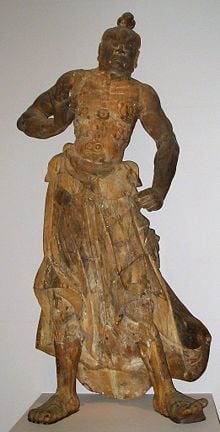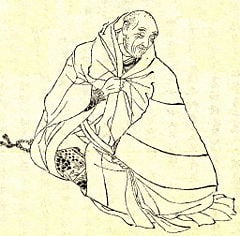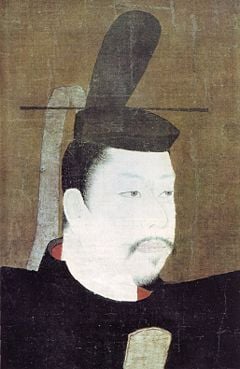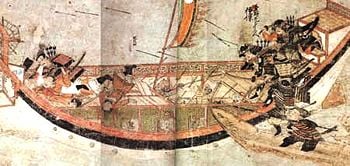Kamakura Period
 From Nwe
From Nwe 
The Kamakura period (鎌倉時代; Kamakura-jidai; 1185–1333) is a period of Japanese history that marks the governance of the Kamakura Shogunate (鎌倉幕府 Kamakura bakufu); officially established in 1192 by the first Kamakura shogun Minamoto no Yoritomo (源 頼朝). Yoritomo relocated his government from Kyoto to Kamakura city to minimize the political influence of the aristocratic families and old Buddhist sects who were located in Kyoto.
During much of the Kamakura period, the government was dominated by a regency of the Hōjō clan using figurehead shoguns. The Kamakura period marked the transition to the Japanese "medieval" era, a nearly 700-year period during which the emperor (天皇 tennō), the court, and the traditional central government were left intact but were largely relegated to ceremonial functions. A feudal system was introduced in which civil, military, and judicial matters were controlled by the bushi (武士, warrior) class. Japan's first military code of law, the Goseibai Shikimoku (御成敗式目), or the Joei Code (貞永式目), adopted in 1232, reflected the profound transition from court to samurai society. The power of traditional Buddhist sects was minimized in Kamakura, and a number of notable Buddhists such as Dogen, Honen, Shinran, Nichiren, Eisai, and Ippen started new Buddhist movements. The foundation of two new sects, Jodo-shu (Pure Land Buddhism 浄土宗) by Honen and Shinran and Zen (禅, Meditation) by Dogen, S popularized Buddhism and Buddhist culture flourished. The literature of the Kamakura period, including Hōjōki (方丈記, An Account of My Hut) and Heike monogatari (平家物語, The Tale of the Heike) reflected Buddhist themes such as the transience of life and the need to cultivate an inner spiritual life.
The Kamakura period ended in 1333 with the destruction of the shogunate and the brief re-establishment of imperial rule under Emperor Go-Daigo (後醍醐天皇 Go-Daigo Tennō) by Ashikaga Takauji (足利 尊氏), Nitta Yoshisada (新田 義貞), and Kusunoki Mashige (楠木 正成).
Rise of Military Government

From 856 until 1086, the Fujiwara clan dominated the government of Japan, and controlled the imperial court. During this period, other clans began to consolidate vast territories and build large standing armies of their own. The two most powerful clans were the Taira (Heike), who had power in both eastern and western Japan, and the Minamoto (Genji), who controlled most of eastern Japan. In 1155, however, the succession to the throne fell vacant, and factional divisions erupted within the imperial court. In 1156, a power struggle erupted between Cloistered Emperor Sutoku and his younger brother, the newly installed Emperor Go-Shirakawa. Sutoku attempted to take the throne with the support of the Minamoto warrior clan, under the leadership of Minamoto Tameyoshi. During the bloody and bitter conflict which followed, known as the Hōgen Rebellion, Taira Kiyomori supported Emperor Go-Shirakawa. He eventually prevailed, after Minamoto Tameyoshi’s son Yoshitomo defected to the Taira side. Kiyomori then ruthlessly executed his enemies, including Minamoto Tameyoshi. This made Tameyoshi’s son, Minamoto no Yoshitomo, leader of the Minamoto clan. His grandson, Minatomo no Yoritomo, received a court title and was appointed an imperial administrator.
This victory established the Taira and Minamoto samurai clans as the top warrior clans in Kyoto. However, the two clans entered into a bitter rivalry. During the winter of 1159, dissatisfied with the rewards he had received for his role in the Hōgen victory, Minamoto Yoshimoto took advantage of Taira Kiyomori’s absence from the capital to seize power, precipitating the Heiji Disturbance. Caught off-guard, Taira Kiyomori mustered his forces and used a series of clever maneuvers to overpower the Minamoto. He returned victorious to Kyoto and eliminated the remaining members of the Minamomoto clan, but, at the request of his wife, he showed mercy to Yoshitomo's three youngest sons Yoritomo, Minamoto no Noriyori, and Yoshitsune and exiled them.
In 1167, Taira Kiyomori became the first courtier of a warrior family to be appointed Daijō Daijin, chief minister of the government, the highest official position at court and the de facto administrator of the imperial government. However, he antagonized both his allies and members of the court by behaving arrogantly, marrying his daughter into the imperial family, and eventually deposing Emperor Takakura and placing his own two-year-old grandson on the throne. In 1180, Prince Mochihito, brother of Emperor Takakura, called on Kiyomori's old rivals, the Minamoto clan, to rise against the Taira, beginning the Genpei War. Taira Kiyomori died the next year, and in 1185, Minamoto Yoritomo eliminated the last of the Taira clan, and established Minamoto supremacy throughout Japan.
Bakufu and the Hōjō Regency
Establishment of the Bakufu

The Kamakura period (1185–1333) marks the transition to the Japanese "medieval" era, a nearly 700-year period during which the emperor (天皇 tennō), the court, and the traditional central government were left intact but were largely relegated to ceremonial functions. A feudal system was introduced in which civil, military, and judicial matters were controlled by the bushi (武士, warrior) class, the most powerful of whom was the de facto national ruler. This period in Japan differed from the old shōen system in its pervasive military emphasis.
Once Minamoto Yoritomo had consolidated his power, he established a new government at his family home in Kamakura. He called his government a bakufu (幕府, tent government), but because he was given the title Seii Tai-shōgun (征夷大将軍) by the Emperor, the government is often referred to in Western literature as the shogunate. Yoritomo followed the Fujiwara form of house government and established an administrative board, a board of retainers, and a board of inquiry. After confiscating Taira estates in central and western Japan, he had the imperial court appoint stewards for the estates and constables for the provinces. As shogun, Yoritomo was both the steward and the constable general. The Kamakura bakufu was not a national regime, however, and although it controlled large tracts of land, there was strong resistance to the stewards. The regime continued warfare against the Fujiwara in the north, but never brought either the north or the west under complete military control. The old court resided in Kyoto, continuing to hold the land over which it had jurisdiction, while newly organized military families were attracted to Kamakura.
Hōjō Regency
Though Yoritomo had eliminated most his most dangerous rivals, contention continued to exist within the Minamoto clan. When Yoritomo died suddenly in 1199, his 18-year-old son Minamoto no Yoriie (源 頼家) became shogun and nominal head of the Minamoto, but was unable to control the other eastern bushi families. Yoriie’s mother, Hōjō Masako, established a council of regents including her father, Hōjō Tokimasa (北条時政), and her brother Hōjō Yoshitoki (義時). She shaved her head and became a Buddhist nun, receiving a tonsure from the priest Gyōyū, but she did not take up residence in a monastery and still involved herself in politics. Yoriie hated his mother's family and preferred his wife's family, the Hiki clan (比企), and his father-in-law, Hiki Yoshikazu (比企能員). After Hōjō Masako caught Yoriie plotting with the Hiki clan to take over the government, the Hiki were executed, and he retired to Izu province where he was murdered in 1204.
In 1203, Masako's other son by Yoritomo, Minamoto no Sanetomo (源実朝), became the third shogun, Shogun Sanetomo(源実朝), with Hōjō Tokimasa (北条時政) as regent. Tokimasa was forced to abdicate in 1205, and was sent to live in a monastery in Kamakura. Masako’s brother Yoshitoki (義時) took his place as shikken or regent for Shogun Sanetomo (源実朝). In 1219, Shogun Sanetomo went to a temple in Tsurugaoka (鶴岡八幡宮) to preside over a ceremony, and was assassinated by his nephew, Kugyo (公暁), the second son of Minamoto no Yoriie, who had been sent there after his father’s death to become a monk. As the next shogun, Masako and Regent Yoshitoki finally decided on Kujo Yoritsune (九条頼経), otherwise known as 'Fujiwara no Yoritsune (藤原頼経), who was still an infant. Since Yoritsune was still a small child, Masako acted as shogun in his place.
In 1221, Cloistered Emperor Go-Toba rebelled against the Hōjō, and attempted to restore power to the emperor. He raised an army in Kyoto and called on all Japan to conquer the Shogunate. Regent Yoshitoki and his eldest son and heir, Hōjō Yasutoki (北条泰時), attacked Kyoto with 190,000 samurai, regained the city and exiled Cloistered Emperor Go-Toba. This was known as the abortive Jōkyū War (承久の乱), or the Jōkyū Disturbance. After this defeat by the Hōjō forces, the imperial court was brought under direct bakufu control. The shogun's constables gained greater civil powers, and the court was obliged to seek Kamakura's approval for all of its actions. Although deprived of political power, the court was allowed to retain extensive estates with which to sustain the imperial splendor, and the bakufu continued to use the emperor to sanction its rule.
In 1224, Hōjō Yoshitoki died of a sudden illness and was succeeded by his eldest son and heir, Hōjō Yasutoki (北条泰時), Masako's nephew. The powerful Miura clan (三浦), led by Miura Yoshimura (三浦義村) and supported by Hōjō Yoshitoki (北条義時)’s second wife, attempted to topple the Hōjō government of Regent Yasutoki, Masako, and Shogun Yoritsune. Masako rushed to negotiate; the Miura were put down, and Regent Hōjō Yasutoki(北条泰時)was re-instated as the Hōjō regent. After Masako Hōjō’s death in 1225, Yoritsune remained a figurehead for the Hōjō.
Several significant administrative achievements were made during the Hōjō regency. In 1225, the third regent Hōjō Yasutoki (北条 泰時) established the Council of State (評定衆 HyoJo-Shu), providing opportunities for other military lords to exercise judicial and legislative authority at Kamakura. The Hōjō regent presided over the council, which was a successful form of collective leadership. The adoption of Japan's first military code of law, the Goseibai Shikimoku (御成敗式目), or the Joei Code (貞永式目), in 1232, reflected the profound transition from court to militarized society. While legal practices in Kyoto were still based on 500-year-old Confucian principles, the Joei Code was a highly legalistic document that stressed the duties of stewards and constables, provided means for settling land disputes, and established rules governing inheritances. It was clear and concise, stipulated punishments for violators of its conditions, and remained in effect for the next 635 years.
Literature
The literature of the time reflected the unsettled nature of the period. The Hōjōki (方丈記, An Account of My Hut) describes the turmoil of the period in terms of the Buddhist concepts of impermanence and the vanity of human projects. The Heike monogatari (平家物語, The Tale of the Heike) narrated the rise and fall of the Taira (平, also known as the Heike, 平家), replete with tales of wars and samurai exploits. A second literary mainstream was the continuation of anthologies of poetry in the Shin Kokin Wakashū (新古今和歌集, New Collection of Ancient and Modern Waka), of which twenty volumes were produced between 1201 and 1205.
The Popularization of Buddhism
During the Kamakura era, disunity and violence resulted in a deepening pessimism, which increased the appeal of the search for spiritual salvation. The popularity of Buddhism began to spread among the ordinary people. The Heian Buddhist sects had been esoteric, more attractive to intellectuals than to the masses. The monasteries of Mount Hiei (比叡山, Hiei-zan) had become politically powerful, but appealed primarily to those capable of systematic study of the sect's teachings.
Two new sects, Jodo-shu (Pure Land Buddhism 浄土宗) and Zen (禅, Meditation), made Buddhism more available to common people. The Jodo sect taught that salvation could be achieved based on unconditional faith and devotion, and prayer to Amida Buddha. Zen rejected all temporal and scriptural authority, stressing moral character rather than intellectual attainments, an emphasis that appealed to the military class. Growing numbers of samurai turned to Zen masters, whom they regarded as embodiments of truth.
The following are simplified introductions to the basic tenets of the schools of Buddhism which began during the Kamakura era:
-
- Jōdoshū (浄土宗): All we need do is to keep praying.
-
- Jōdo-shinshū (浄土真宗): All we need do is to believe and trust because Buddha saves everyone who believes.
-
- Jishū (時宗): We are relieved only by praying, including a most remarkable dancing prayer to Buddha.
-
- Rinzaishū (臨済宗): We must adhere to Indian Buddhism, respecting Buddhist law and Zen meditation.
-
- Sotoshū (曹洞宗): We must sit in meditation single-mindedly.
-
- Nichiren Buddhism (日蓮宗): We must follow the Lotus Sutra; all other forms of Buddhism are heretical.
Mongol Invasions
The repulsions of two Mongol invasions during the Kamakura period were momentous events in Japanese history. Japanese relations with China had been terminated in the mid-ninth century after the deterioration of late Tang Dynasty China and the turning inward of the Heian court. Some commercial contacts were maintained with southern China (南宋, Southern Song Dynasty) in later centuries, but Japanese pirates made the open seas dangerous. At a time when the bakufu had little interest in foreign affairs and ignored communications from China and Goryeo (高麗, as Korea was then known), news arrived in 1268 of a new Mongol regime in Beijing. Its leader, Khubilai Khan, demanded that the Japanese pay tribute to the new Yuan Dynasty (元, 1279–1368) and threatened reprisals if they failed to do so. Unused to such threats, the court at Kyoto emphasized Japan's divine origin, rejected the Mongol demands, dismissed the Korean messengers, and started defensive preparations.

After further unsuccessful entreaties, the first Mongol invasion took place in 1274. More than 600 ships carried a combined Mongol, Chinese, and Korean force of 23,000 troops armed with catapults, combustible missiles, and bows and arrows. In fighting, these soldiers were grouped in close cavalry formations against samurai, who were accustomed to one-on-one combat. Local Japanese forces at Hakata, on northern Kyūshū, defended against the superior military power of the invading force. After one day of fighting, a sudden typhoon blew up and decimated the Mongol navy. Khubilai Khan launched a second invasion in 1281. Seven weeks of fighting took place in northwestern Kyūshū before another typhoon struck, again destroying the Mongol fleet.
Although Shinto priests attributed the two defeats of the Mongols a "divine wind" (kamikaze), a sign of heaven's special protection of Japan, the invasion left a deep impression on the bakufu leaders. Long-standing fears of the Chinese threat to Japan were reinforced. The Japanese victory, however, gave the bushi a sense of fighting superiority that remained with Japan's soldiers until 1945. The victory also convinced the bushi of the value of the bakufu form of government.
Civil War and End of the Kamakura Shogunate
The war against the Mongol invaders had been a drain on the economy, and new taxes had to be levied to maintain defensive preparations for the future. The invasions also caused disaffection among those who expected recompense for their help in defeating the Mongols. There were no lands or other plunder to be distributed, however, and such disaffection, combined with overextension and the increasing defense costs, led to a decline of the Kamakura bakufu. Additionally, the laws of inheritance had divided family properties into smaller and smaller estates, and landowners increasingly had to turn to moneylenders for support. Roving bands of ronin (disaffected samurai) further threatened the stability of the bakufu.
The Hōjō reacted to the ensuing chaos by trying to place more political power in the hands of the various great family clans. To further weaken the Kyoto court, the bakufu decided to allow two contending imperial lines—known as the Southern Court (南朝) or junior line, and the Northern Court (北朝) or senior line—to alternate on the throne. The strategy worked for several successions, until a member of the Southern Court ascended to the throne as Emperor Go-Daigo (後醍醐天皇 Go-Daigo Tennō, r. 1318–1339). Go-Daigo wanted to overthrow the bakufu, and he openly defied Kamakura by naming his own son his heir. In 1331 the bakufu exiled Go-Daigo, but loyalist forces, including Kusunoki Masashige (楠木 正成), rebelled. They were aided by Ashikaga Takauji (足利 尊氏, 1305–1358), a constable who turned against Kamakura when he was dispatched to put down Go-Daigo's rebellion. At the same time, Nitta Yoshisada (新田 義貞), another eastern chieftain, rebelled against the bakufu, which quickly disintegrated, and the Hōjō were defeated.
Kemmu Restoration
In the swell of victory, Go-Daigo endeavored to restore imperial authority and tenth-century Confucian practices. This period of reform, known as the Kemmu restoration (建武の新政 Kemmu no shinsei, 1333–1336), aimed at strengthening the position of the Emperor and reasserting the primacy of the court nobles over the bushi. However, the Go-Daigo regime had neither the administrative experience nor the provincial power to deal with the realities of a warrior-dominated society. In 1335, when Go-Daigo ws asked to appoint Ashikaga Takauji shogun, he refused. Ashikaga Takauji finally sided with the Northern Court in a civil war against Go-Daigo and the Southern Court, the War Between the Courts (1336 to 1392). After a clash with Takauji in 1336, Go-Daigo fled south from Kyoto to Yoshino, and the Northern Court contender was installed as Emperor by Ashikaga, who became the new shogun and established a new bakufu in Kyoto, known as the Muromachi shogunate (1336 – 1573) .
Events
- 1192: The emperor appoints Yoritomo as shogun (military leader) with a residence in Kamakura, establishing the bakufu system of government
- 1199: Minamoto Yoritomo dies and is replaced by the Hōjō regency
- 1221: The Kamakura army defeats the imperial army in the Jōkyū Disturbance, thereby asserting the supremacy of the Kamakura shogunate (Hōjō regents) over the emperor
- 1227: The Sōtō sect of Zen Buddhism is introduced to Japan by the monk Dōgen Zenji
- 1232: The Jōei Shikimoku code of law is promulgated to enhance control by the Hōjō regents
- 1274 and 1281: The Mongols of Kublai Khan try to invade Japan but are repelled by a kamikaze
- 1331: Emperor Go-Daigo is exiled, but his supporters, led by Ashikaga Takauji , defeat the Hōjō and re-instate him.
References
ISBN links support NWE through referral fees
- Conlan, Thomas. 2003. State of war: the violent order of fourteenth-century Japan. Michigan monograph series in Japanese studies, no. 46. Ann Arbor: Center for Japanese Studies, University of Michigan. ISBN 1929280165 ISBN 9781929280162 ISBN 1929280238 ISBN 9781929280230
- Mass, Jeffrey P. 1982. Court and Bakufu in Japan: essays in Kamakura history. New Haven: Yale University Press. ISBN 0300026536 ISBN 9780300026535
- Mass, Jeffrey P. 1979. The development of Kamakura rule, 1180-1250: a history with documents. Stanford, CA: Stanford University Press. ISBN 0804710031 ISBN 9780804710039
- Perkins, George W. 1998. The clear mirror: a chronicle of the Japanese court during the Kamakura period (1185-1333). Stanford, CA: Stanford University Press. ISBN 0804729530 ISBN 9780804729536
- Shinoda, Minoru. 1960. The founding of the Kamakura shogunate, 1180-1185. Records of civilization: sources and studies, no. 57. New York: Columbia University Press.
Credits
New World Encyclopedia writers and editors rewrote and completed the Wikipedia article in accordance with New World Encyclopedia standards. This article abides by terms of the Creative Commons CC-by-sa 3.0 License (CC-by-sa), which may be used and disseminated with proper attribution. Credit is due under the terms of this license that can reference both the New World Encyclopedia contributors and the selfless volunteer contributors of the Wikimedia Foundation. To cite this article click here for a list of acceptable citing formats.The history of earlier contributions by wikipedians is accessible to researchers here:
- Kamakura period history
The history of this article since it was imported to New World Encyclopedia:
- History of "Kamakura period"
Note: Some restrictions may apply to use of individual images which are separately licensed.
↧ Download as ZWI file | Last modified: 02/04/2023 01:05:29 | 61 views
☰ Source: https://www.newworldencyclopedia.org/entry/Kamakura_period | License: CC BY-SA 3.0
 ZWI signed:
ZWI signed: KSF
KSF